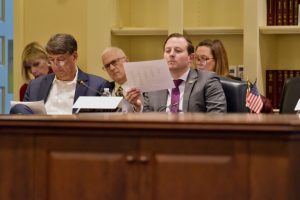
Billions of dollars in collected operating and transportation budget deficits will present Gov. Wes More (D) with one of the toughest challenges of his nascent administration.
Ever ebullient, Moore was sworn in earlier this year vowing to move quickly to rebuild state government, end childhood poverty and leave no one behind as he promised that the state would “win the decade.” Those ambitions are about to be tested against stark budget realities that will make Moore, as with all governors, pick and choose and prioritize.
State Budget Secretary Helene Grady said addressing the coming budget challenges requires a “disciplined approach to the fiscal 2025 budget, one that involves hard choices.”
Grady’s comments mirror those made by Moore in speeches to the Maryland Association of Counties in August and this month.
Moore entered the governor’s office with a historic budget surplus.
That surplus was bolstered by unprecedented federal pandemic aid. After billions of dollars in budgetary sugar highs, a crash was inevitable.
Maryland faces a $761 million budget shortfall projected for the fiscal 2025 budget, which the General Assembly must pass in early 2024.
Comptroller Brooke Lierman (D) said much of the recent write down of state revenues adopted by the Board of Revenue Estimates stems from declining sales tax collections.
“This appears in part to be another post-pandemic behavior as consumers have generally spent pandemic savings or stimulus funds and are now looking to rebuild savings,” she said.
The state’s budget faces short-term challenges that grow worse over the current five-year outlook presented last week by legislative budget analysts.
Over the next five years, revenues are expected to grow 3.5% annually. Those are outpaced by expected spending growth of 5% annually over the same period.
Members of the legislative Spending Affordability Committee adopted recommendations last week that call for a series of one-time budget actions to attack the 2025 deficit.
The panel recommended reducing the initial gap by about 33% to $508 million. That could be done through a series of accounting moves including budget reversions and paying for some capital projects with bonds rather than cash.
The panel also approved a recommendation that would allow the legislature to tap the state’s rainy day fund, which stands at 10% of current revenues. The proposal would allow lawmakers to pump $375 million into the budget on one-time costs, further reducing the gap.
Those moves will mostly address near-term problems.
Some, like Senate Budget and Taxation Vice Chair Sen. Jim Rosapepe (D-Anne Arundel and Prince George’s) question the need to tap the rainy day fund so early.
“I think it’s important to keep the rainy day fund well-funded for a rainy day,” he said. “That’s why the recommendation is it’s like don’t do it unless there’s some good reason to do it.”
When asked if it was “raining yet,” Rosapape responded: “It isn’t raining at all, the sun is out. The stock market just went up. The unemployment numbers are still very low. Inflation is coming down. Gas prices are coming down. So I mean, no.”
Leaving the rainy day fund untouched this year would give Moore and lawmakers options in the future.
Looming in the out-years of a five-year budget forecast are deficits that balloon to $2.7 billion by 2029.
Much of that is caused by spending spikes tied to education reforms in the Blueprint for Maryland’s Future.
“It is real,” said Senate Budget and Taxation Chair Sen. Guy Guzzone (D-Howard). “And it’s really real if you have an absolute clear commitment to getting things done, like the Blueprint.”
Republicans and leaders of some local governments including Prince George’s County say the pinch to their budgets from paying for the education plan is too much. Some want to see it curtailed or reworked.
“They’re going to roll back [the Blueprint] at the state level or they’re just going to have to, at the local level, continue issuing these [funding] waivers,” said House Minority Whip Del. Jesse T. Pippy (R-Frederick).
Watching for recession, shutdowns
Also of concern is the risk of recession and a renewed potential for a federal government shutdown early next year.
Over the last year, the Federal Reserve raised interest rates to ease inflation and lower the potential for a deep recession.
Those efforts appear to be working. The reserve signaled last week that it will look to lower interest rates in 2024.
“I have been surprised by how amazingly well the economy has dealt with these high borrowing costs,” said economist Anirban Basu, founder of Sage Policy Group.
Basu said he remains “cautiously pessimistic” about a recession in the coming year.
“I still believe we will have a recession in early 2024,” he said. “It’ll be a mild recession. I still think it’s coming. More and more people — I’m speaking to bankers and construction firms — are saying things really are slowing down.”
At the same time, a Republican-led Congress could force a government shutdown and disproportionately affect Maryland because of the state’s substantial number of federal workers, contractors, and military personnel.
“The short-term deal that was reached in November expires next month and we could be back on the precipice of another shutdown early next year,” said Lierman. “I’m not sure how this became the new normal, but it’s incredibly frustrating and certainly irresponsible. So, I certainly urge our federal colleagues to not let this happen.”
The specter of tax increases
Some worry that tax hikes are coming.
“This budget cycle, I think they’ll be able to satisfy it without draconian things,” said House Minority Leader Jason Buckel (R-Allegany), a member of the Spending Affordability and House Ways and Means Committees.
Buckel added that it’s difficult to close large gaps in later years by “nibbling around the edges with $10 million here and $30 million there because it’s billions of dollars. So, when we sit on the Ways and Means committee, we see the fiscal notes for every tax increase that’s ever proposed. The only ones that equate to those kinds of money are game-changing, massive tax increases.”
Buckel and other Republicans on the panel oppose tax increases. Democratic supermajorities in the House and Senate will not need Republican votes if such a vote occurs.
And while Senate leaders say it’s too soon to know if tax increases are needed, some local leaders and House of Delegates members are already pitching the idea to prevent cuts.
House Majority Leader David Moon (D-Montgomery) told county leaders at a gathering in Cambridge earlier this month that the House “has generally been okay with trying to do some grown up things” regarding taxes.
He acknowledged a lack of early consensus between the House and Senate but added that it may be time to “pull up some grown-up pants and do something” or resort to “living within our means” and accepting cuts.
Basu, the economist, said Maryland needs a tax overhaul. The state is the seventh worst in terms of taxing its middle class, is the only state with both an inheritance tax and an estate tax and has a high corporate tax rate.
Basu criticized the idea that the state could take a “balanced approach” by making both cuts and raising taxes. “There’s nothing balanced about it, in my view, because we’re already over-taxed as a people, which helps explain why the Virginians and the North Carolinians are attracting more of our people and more of our tax base.”
Doomsday transportation budget
Compounding the problem is a recently announced set of deep cuts to transportation. The reductions address a $3.3 billion gap in the budget for road and transit projects.
Agencies within the transportation department will each see an 8% cut. Local governments will lose aid to priority road projects and local transportation networks.
“The administration will continue to focus on protecting the interests of our state and ensure we’re on firm financial footing as we roll out our agenda,” Grady said. “In particular, we are scrutinizing how state operating and capital dollars are directed with an eye toward prioritizing funds to the state’s primary responsibilities, and the key outcomes that align with our agenda.”
Some of those choices could affect Moore’s vow to “rebuild state government” by reducing an estimated 10,000 vacancies across executive branch agencies and higher education.
Moore is already behind on fulfilling a promise to halve that number.
Currently, the state vacancy rate hovers around 11% excluding higher education.
“I would say compared to the current budget there is room to make significant progress,” David Romans, an analyst for the Department of Legislative Services, said in a legislative briefing last week.
Romans told members of the joint legislative Spending Affordability Committee that Moore could cut that rate to 7% without negatively impacting the budget.
“It is certainly going to take some effort to jump from 11% to 7%,” he said. “If you’re going beyond that, it would add to the budget.”
Some Republicans question the wisdom in filling vacancies rather than banking the savings from lower personnel costs.
“There was no number attached to the expeditiously ramping up of state hiring,” said Del. Jefferson L. Ghrist (R-Upper Shore), a member of the Spending Affordability Committee. “Some positions are essential. We’ve talked about public safety officials. Some positions are not. We don’t know what that cost is. They said they built in a small buffer for it. But you know, the devil is always in the details. If we’re cutting — truly cutting costs — maybe we shouldn’t be hiring new state workers.”



